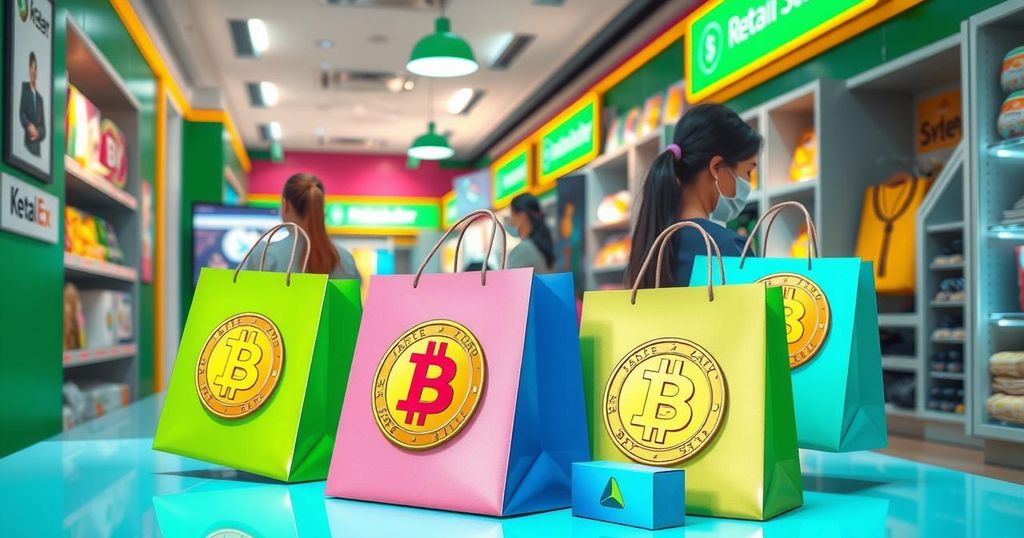Retailers Face a Payment Shift: Cash, Cards, or Cryptocurrency?
Physical retail is rebounding and could hit 80% of global sales this year, pushing retailers to differentiate themselves. Accepting cryptocurrency might provide that unique edge as 87% of executives believe it offers a competitive advantage. With millions of crypto holders in the U.S. and Asia, the shift towards crypto payments is imminent. A supportive political climate and lower costs suggest cryptocurrency could soon be a standard payment method for retailers.
In-store shopping is on the rebound, with predictions indicating that physical retail could soon represent 80% of global retail sales. Amidst intense competition, retailers are urged to embrace differentiation techniques to draw in new customers. Recent insights suggest that accepting cryptocurrency could provide a distinctive edge in attracting tech-savvy shoppers eager for unique purchasing experiences.
A Deloitte survey conducted back in 2021 involving 2,000 senior retail executives found that a staggering 87% believed accepting cryptocurrencies gave them a competitive advantage. Neatly, about 75% of those surveyed planned to integrate cryptocurrency or stablecoin payments within just two years. This shift appears inevitable, as consumers with cryptocurrency investments increasingly seek avenues to spend their digital coins.
Currently, around 65 million Americans—equivalent to nearly 28% of U.S. adults—own cryptocurrencies. This demographic primarily comprises younger Gen Xers and older Millennials, many of whom are keen to capitalise on high asset values. The trend is even more pronounced in Asia, where reports suggest that crypto holders number around 327 million. An upcoming Capital One study suggests that by late 2024, 65% of consumers desire the option to use cryptocurrency for payments, especially for everyday retail goods.
What’s fascinating is Worldpay’s latest payments report, which anticipates global cryptocurrency spending will balloon from $16 billion in 2024 to a staggering $38 billion by 2030. A potential goldmine lies ahead for retailers willing to embrace this payment shift.
Picture crypto-rich individuals purchasing luxury art at auctions or travellers snapping up high-end goods with digital currencies. Restaurants could entice foreign tourists seeking memorable dining experiences, provided they accept crypto payments. Interestingly, from a cost perspective, crypto transactions may turn out to be cheaper than traditional credit card processing fees, provided retailers can streamline the payment experience. Long waiting times at checkout could deter customers.
New payment solutions are emerging that convert crypto to fiat swiftly—sometimes within a mere 15 seconds. It’s essential for retailers to have these transactions occur in tandem. Introducing a ‘buy with crypto’ feature should ideally feel as straightforward as using established payment brands like Visa or Mastercard. QR codes are becoming instrumental in making cryptocurrency payments as easy as tapping a credit card at a point-of-sale terminal.
Merchants looking to implement crypto payments must ensure they don’t expose themselves to the volatility of the crypto market. Backend processes must be simple, with API integrations helping facilitate this new payment landscape seamlessly. Early adopters in the space tend to be physical merchants focusing on non-essential items—think coffee shops, tattoo studios, and cannabis dispensaries.
E-commerce platforms, too, are keen to allow crypto payments, whether for small trifles or high-ticket items. Research from Ernst & Young indicates that a surprising 25% of consumers worldwide would consider purchasing a vehicle entirely online, which underscores the synergy between digital retail and digital currencies.
The current political climate has a strong bearing on cryptocurrency’s rising profile. In the U.S., the President has made clear intentions to establish the nation as a leader in cryptocurrency. With more supportive regulations on the horizon, the transition from a chaotic, nascent market to a recognised payment method seems imminent. As these regulations take shape, it will allow retailers to establish a concrete framework around crypto transactions.
In sum, as crypto’s accessibility and lower processing costs reach broader audiences, it’s reasonable to expect that these digital currencies will become standard payment methods. Despite the ebbs and flows of the market, cryptocurrencies like Bitcoin seem poised for a lasting presence, offering substantial opportunities for retailers willing to adapt to this evolving financial landscape.




Post Comment